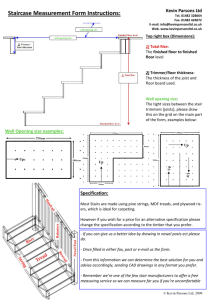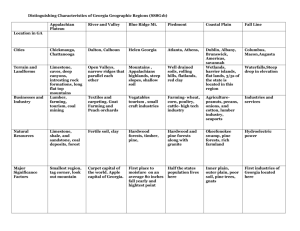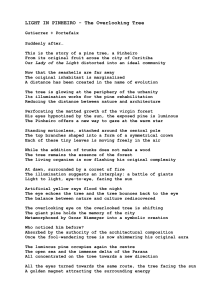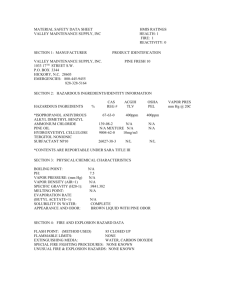84 Abinger Avenue, Cheam
advertisement
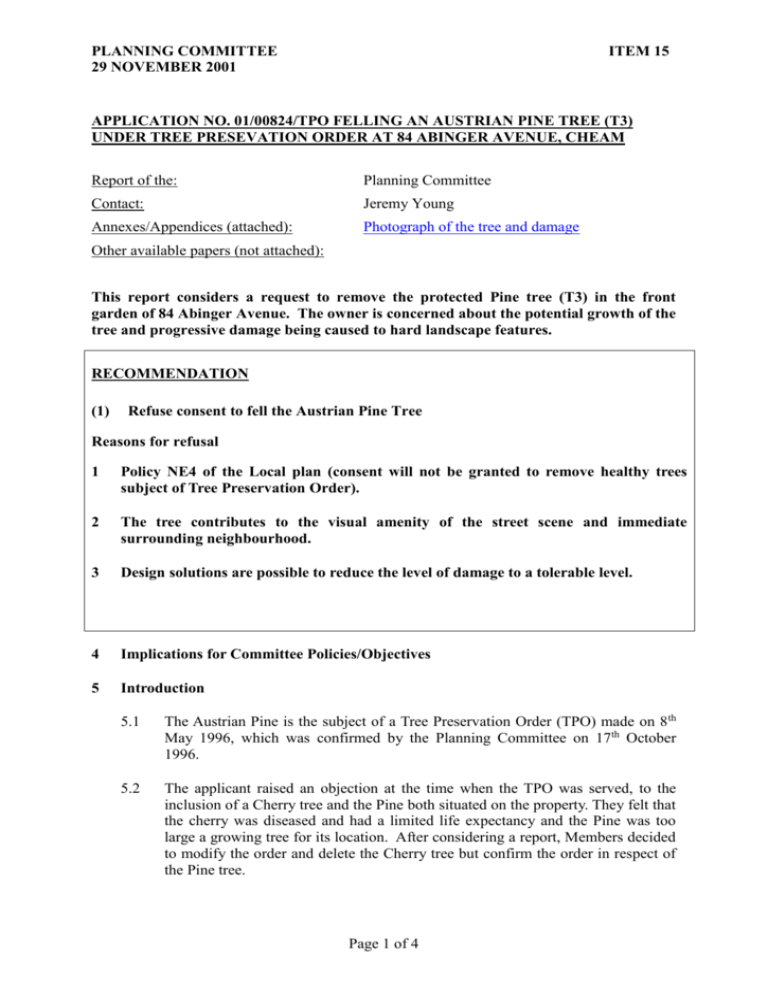
PLANNING COMMITTEE 29 NOVEMBER 2001 ITEM 15 APPLICATION NO. 01/00824/TPO FELLING AN AUSTRIAN PINE TREE (T3) UNDER TREE PRESEVATION ORDER AT 84 ABINGER AVENUE, CHEAM Report of the: Planning Committee Contact: Jeremy Young Annexes/Appendices (attached): Photograph of the tree and damage Other available papers (not attached): This report considers a request to remove the protected Pine tree (T3) in the front garden of 84 Abinger Avenue. The owner is concerned about the potential growth of the tree and progressive damage being caused to hard landscape features. RECOMMENDATION (1) Refuse consent to fell the Austrian Pine Tree Reasons for refusal 1 Policy NE4 of the Local plan (consent will not be granted to remove healthy trees subject of Tree Preservation Order). 2 The tree contributes to the visual amenity of the street scene and immediate surrounding neighbourhood. 3 Design solutions are possible to reduce the level of damage to a tolerable level. 4 Implications for Committee Policies/Objectives 5 Introduction 5.1 The Austrian Pine is the subject of a Tree Preservation Order (TPO) made on 8 th May 1996, which was confirmed by the Planning Committee on 17th October 1996. 5.2 The applicant raised an objection at the time when the TPO was served, to the inclusion of a Cherry tree and the Pine both situated on the property. They felt that the cherry was diseased and had a limited life expectancy and the Pine was too large a growing tree for its location. After considering a report, Members decided to modify the order and delete the Cherry tree but confirm the order in respect of the Pine tree. Page 1 of 4 PLANNING COMMITTEE 29 NOVEMBER 2001 6 ITEM 15 5.3 Incidents of minor damage to the drive, footpath and boundary wall, has reinforced the applicants belief that the roots are to blame and the tree is unsuitable to its setting. Faced with a perceived threat of further damage, as the tree gets larger the applicant has submitted this application to remove the tree. 5.4 The Tree Advisory Board raises objection to the removal of this tree if the damage is deemed to be tolerable. Proposals 6.1 The Austrian Pine is a young-middle aged specimen estimated to be about 30 years old. Austrian Pine has a useful life expectancy of about 100 years. This tree has attained a height of 11.25m. It has an average crown diameter of 9m and a diameter measured at 1.5m above ground level of 430mm. The Pine is of good form and is in an excellent condition. 6.2 Pines tend to display two phases of growth, which merge together. The first phase is the extension in height within the limits set by the environment and exposure. It would seem reasonable to assume that over the next 30-40 years the tree could attain a height of 23m, roughly double its current height. In the second phase of growth many of the lower branches die through shading and because the vigour is taken into the upper system. Upper crown branches thicken to form a definite crown. The tree should remain fairly conical in appearance for the next 30 years with a marginal increase in crown spread to a maximum of around 12m. 6.3 It is certain that this tree is capable of forest type proportions and will not lend itself well to reduction pruning, but one reason for placing trees under tree preservation order is to create a treescape of substantial forest type trees to enhance the landscape. 6.4 The Pine is visually prominent in the street scene being visible at the intersection of Abinger Avenue and Holmwood Road. Approximately 12 properties have a direct view of the tree. 6.5 Situated at over 10m from the house there is the physical space to accommodate the tree, although when fully grown the tree would dominate the house. The height growth will appear exaggerated from the house as the garden slopes upward and the tree is on the top of the slope. It is unlikely that fibrous roots would cause indirect damage to the property caused by moisture extraction. This is because the underlying soil type is understood to be sandy in nature and not prone to shrinkage like clay soils. 6.6 The drains appear to be a sufficient distance form the tree to be unaffected by tree root growth. The drains feed into a main drain, which runs along the North side of the property approximately 15m from the tree. There is a gully in the drive in front of the garage, which appears to link into the main drain by passing below the front garden. This run is approximately 8m from the tree. Anchor roots of large growing tree can damage drains, but direct damage is unlikely if the drain is more than 3m from the tree. On this basis the risk to the drains would seem negligible. Page 2 of 4 PLANNING COMMITTEE 29 NOVEMBER 2001 7 6.7 A half brick, low boundary wall interspersed with brick piers encloses the property. At the closest point the wall is 25cm from the trunk of the tree. The wall has sustained damage (a vertical and horizontal crack and the brick pier has collapsed) in close proximity to the Pine. The most likely explanation for this damage is the expansion force of the main anchor roots. BS 5837: 1991 Trees in relation to construction gives guidance on the planting of new trees to avoid damage to walls. It recommends that trees capable of forest type proportion should be planted 2m or more from boundary walls to avoid root expansion damage. 6.8 The solution to repeated damage to a small section of the wall would be to replace the end section with a picket style fence or similar means of enclosure. 6.9 A crack is apparent in the concrete drive near the tree, but there is also evidence of material degradation well away from the tree by the gully. The tree is 1.2m from the drive and at this proximity it is likely that some minor movement and damage will occur. It is suggested that the level of damage might be tolerable. 6.10 There is an area of subsidence/lifting in the highway running along the service trench excavated by Nynex. The tree officer has asked the highways section to inspect to access whether it can be repaired. Financial and Manpower Implications 7.1 8 9 ITEM 15 Non for the purpose of this report Human Rights and Other Legal Implications 8.1 The local planning authority may become liable for compensation claims for loss or damage caused or incurred as a result of: their refusal of any consent under the TPO, or their grant of a consent subject to conditions. Claims can only be made for a period of one year from the date of the decision. 8.2 Claims for compensation would normally be limited to amounts over £500. 8.3 TPO`s made before 2nd of August 1999 allow the Local Planning Authority to issue an article 5 certificate that certifies that a tree is of special or outstanding amenity value. This certificate protects the Council from claims of compensation but can be cancelled at appeal to the Secretary of state. Although the Pine tree has good amenity value It is not currently outstanding so an article 5 certificate would be inappropriate. Social Well-being 9.1 Non for the purpose of this report Page 3 of 4 PLANNING COMMITTEE 29 NOVEMBER 2001 ITEM 15 10 Economic Well-being 10.1 Non for the purpose of this report 11 Environmental Well-being 11.1 Trees enhance the environment. 12 Conclusions 12.1 The application conflicts with the Councils policy in respect of retaining healthy trees under. 12.2 There appears to be no evidence to substantiate that there is a risk to the drains 12.3 The Pine has good amenity value, which will increase as the tree becomes larger. It is visually prominent in the street scene at the junction of two suburban roads. The loss of the tree will adversely affect the character of the landscape in the immediate vicinity. 12.4 Damage has been sustained to the wall, but it is deemed that rectification works to provide an alternative means of enclosure for a small section of the wall would not be unreasonably onerous on the applicant. 12.5 It is conceivable that some minor damage to the drive and footpath may continue as the tree matures. However, this is not a foregone conclusion because tree roots can be so variable. It is suggested that damage may be of a tolerable nature and a further applications could be considered if damage became extreme. 12.6 If members believe that some loss or damage is likely as a result of refusing consent then it does not necessarily follow that consent should be granted; it should be taken into account alongside other key considerations, such as the amenity value of the tree. 12.7 The Pine has the ability to become a large dominant tree. On balance the value of its retention, in terms of its current and potential impact on the landscape would seem to outweigh the disadvantages. WARD(S) AFFECTED: Nonsuch Page 4 of 4



